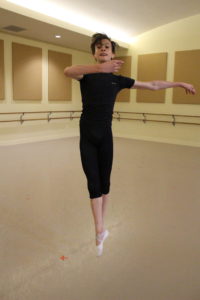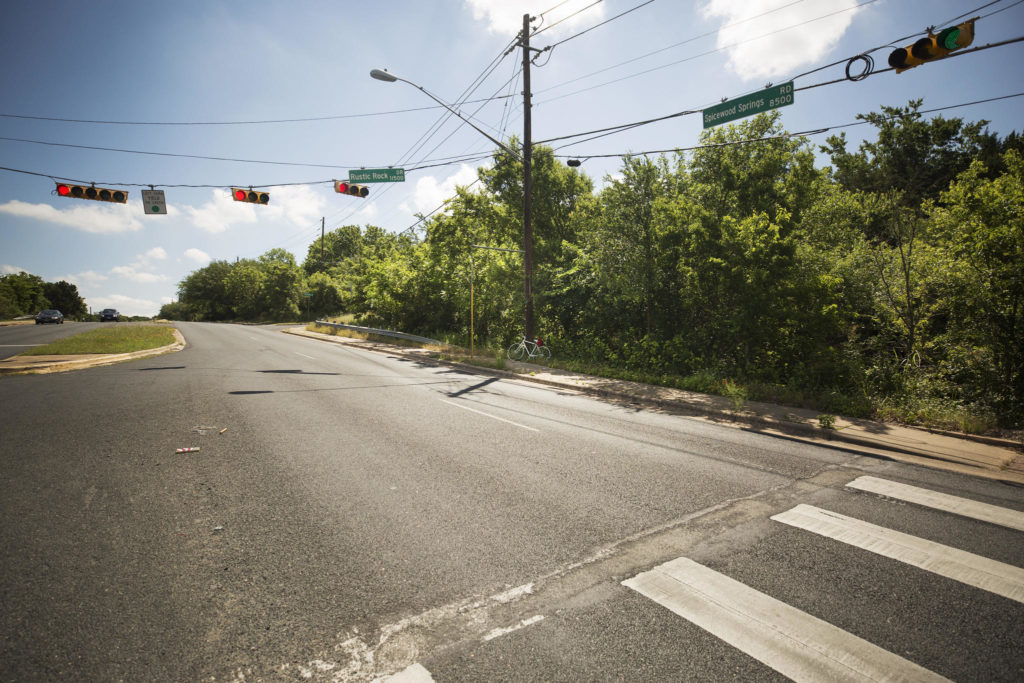Two years after Vision Zero, when will Austin streets be safer for pedestrians?
Wednesday, May 16, 2018 by
Audrey McGlinchy, KUT Before he was killed, 14-year-old Alexei Bauereis had quit the backyard stunts like jumping from trees onto roofs and downhill skateboarding that defined his childhood. He was saving his legs for ballet.
“Dance was so important to him,” said Eric Bauereis, Alexei’s dad.
Just past 10 p.m. on June 7, 2016, a driver hit and killed Alexei near his family’s home in far-Northwest Austin. Alexei had been hanging out with a friend when he offered to walk his friend the roughly six blocks home. The journey required crossing the four lanes of Spicewood Springs Road at the top of a hill.
The traffic lights turned to flashing red and flashing yellow signals just after 9 p.m., according to the police report. The signal to let pedestrians cross had also shut off when the lights changed. As he was crossing the street, a man driving a Toyota SUV hit Alexei and killed him.

“The real question was, ‘What happened here?’” Bauereis said. “And I guess to a certain extent, ‘Whose fault was it?’ We really believed that a major contributor to the accident was the intersection itself.”
The idea that road design can help dictate the safety of the road isn’t unfamiliar to the city of Austin.
In May 2016, it passed the Vision Zero Action Plan, which outlines an aggressive goal of reducing traffic deaths and serious injuries on Austin roads to zero by 2025. Since then, fatal crashes have dropped slightly, but pedestrians still represent roughly a third of the deaths.
Nationally, traffic deaths have been on the rise since 2009, and pedestrians are increasingly a larger portion of those killed.
“And it appears possibly that Austin is kind of staying where it is, which itself might be a remarkable feat,” said Jay Blazek Crossley, the executive director of Farm & City, a nonprofit that lobbies for safe streets and transit across Texas.
Several pedestrian-safety advocates KUT spoke to for this story said the city’s done a fair job of making streets safer for pedestrians in the two years since the Vision Zero plan passed. But these same advocates say the city will need to step up its efforts if it’s going to dramatically lower the number of traffic fatalities each year.

‘The intersection itself’
In 2017, Bauereis sued both the driver and the city of Austin seeking damages for his son’s death, claiming that the city’s design of the intersection was partly to blame.
“The light shouldn’t change to flashing red and flashing yellow so early in the evening when it’s populated with kids,” said Bauereis.
A couple of weeks after Alexei’s death, the city tweaked the timing of the traffic light, pushing back the start time of the flashing lights from 9 p.m. to 11 p.m.
Bauereis says his case against the city was dismissed.
But Bauereis was onto something.
By passing a Vision Zero plan, local elected officials and city staff bought into the idea that drivers, bicyclists and pedestrians will make mistakes on city streets, but that roads should be designed to prevent death as a result.
But that decision to address design to avoid traffic fatalities was spurred by the record-high number of traffic deaths in 2015. Of the 102 deaths, 30 were pedestrians. In 2016, 28 pedestrians died on Austin’s roads, making up 35 percent of total traffic deaths. In 2017, 23 pedestrians died, roughly 30 percent of the year’s traffic fatalities. Eight of 23 traffic deaths so far this year have been pedestrians.
In response, the Austin Transportation Department said it has tried to institute systemwide changes to pedestrian infrastructure across the city by installing more pedestrian signals and redesigning some of Austin’s most dangerous intersections. Heyden Black Walker, an urban planner who serves on the city’s Pedestrian Advisory Council, said design often dictates to drivers the right they have to the road – including how fast they feel comfortable driving.
“When we started building streets and roads, we started coming up with standards, and for highways we came up with standards where lanes are really, really wide,” said Walker. “There’s not a lot of visual clutter,” which, she said, would force a driver to slow down.
Walker commutes to work by bus from her home in Allandale. Every day along her half-mile walk to the bus stop, she said she encounters nearly every type of road in Austin – quiet residential streets with no sidewalks, busy streets with sidewalks and the bustling four-lane road with dicey pedestrian crossings.
Walker pointed to the intersection at Burnet Road and West Koenig Lane, which is close to her bus stop, as a particularly dangerous one. She says the majority of the time drivers whip around the corners without stopping.
“They can do it quickly because the corner has a huge turning radius,” Walker said. “They don’t have to slow down very much.”
She says she’s hopeful the number of pedestrian deaths is trending downward – but that hope is tempered by caution.
“The population is increasing and the numbers is staying the same,” said Walker. “So, the rate is going down which I think is important to note. But I don’t know how we know we have a goal to have zero traffic fatalities by 2025. It’s going to take a lot of effort to get there.”
Consistency Is Key
Despite losing his case against the city, Bauereis still contends that the design of the intersection Alexei tried to cross on that June night in 2016 is partly to blame for his son’s death.
“I do think that the city should be able to have more consistent and better design and better practices around our intersections that would protect both drivers, cyclists and pedestrians,” he said.
Tom Wald, who serves on the board of the nonprofit Walk Austin, agrees. While the city and the state are ramping up pedestrian-minded safety efforts, he said Austin isn’t doing enough.
“They have resources that they could devote to addressing traffic safety that they instead devote to ensuring that people have shorter commutes,” he said.
Wald said, for example, the city could more quickly respond to pedestrian deaths by putting in temporary or low-cost design elements to slow drivers.
“So, when there is a fatality or a serious injury collision, that we look at how that roadway is contributing to that,” he said. “Looking at that, fixing it relatively quickly and also fixing the other similar situations that we see in other parts of Austin.”
Wald cited the intersection of East Sixth Street and Waller Street as an example, where in 2016 the city installed bollards and “turtle shells” – the small, round bumps in the street – to slow cars passing through the intersection. Both the bollards and the turtle shells, which cost the city considerably less than a full-scale redesign of the intersection, were destroyed by cars.
Typically, the city waits to review traffic deaths at any intersection and coordinates with engineers and regional transportation agencies before proposing solutions. It’s not necessarily a quick-fix process.
Bauereis says his son’s death has pushed his wife and him into activism to help speed up those processes. So far, they’ve met with the Pedestrian Advisory Council and Walk Austin, among others. But he says it hasn’t been easy while coping with the loss of their son.
“How do you appropriately grieve, move forward and help others all at the same time?”
This story was produced as part of the Austin Monitor’s reporting partnership with KUT. Photos by Julia Reihs and KUT. This story has been updated.
The Austin Monitor’s work is made possible by donations from the community. Though our reporting covers donors from time to time, we are careful to keep business and editorial efforts separate while maintaining transparency. A complete list of donors is available here, and our code of ethics is explained here.
You're a community leader
And we’re honored you look to us for serious, in-depth news. You know a strong community needs local and dedicated watchdog reporting. We’re here for you and that won’t change. Now will you take the powerful next step and support our nonprofit news organization?








